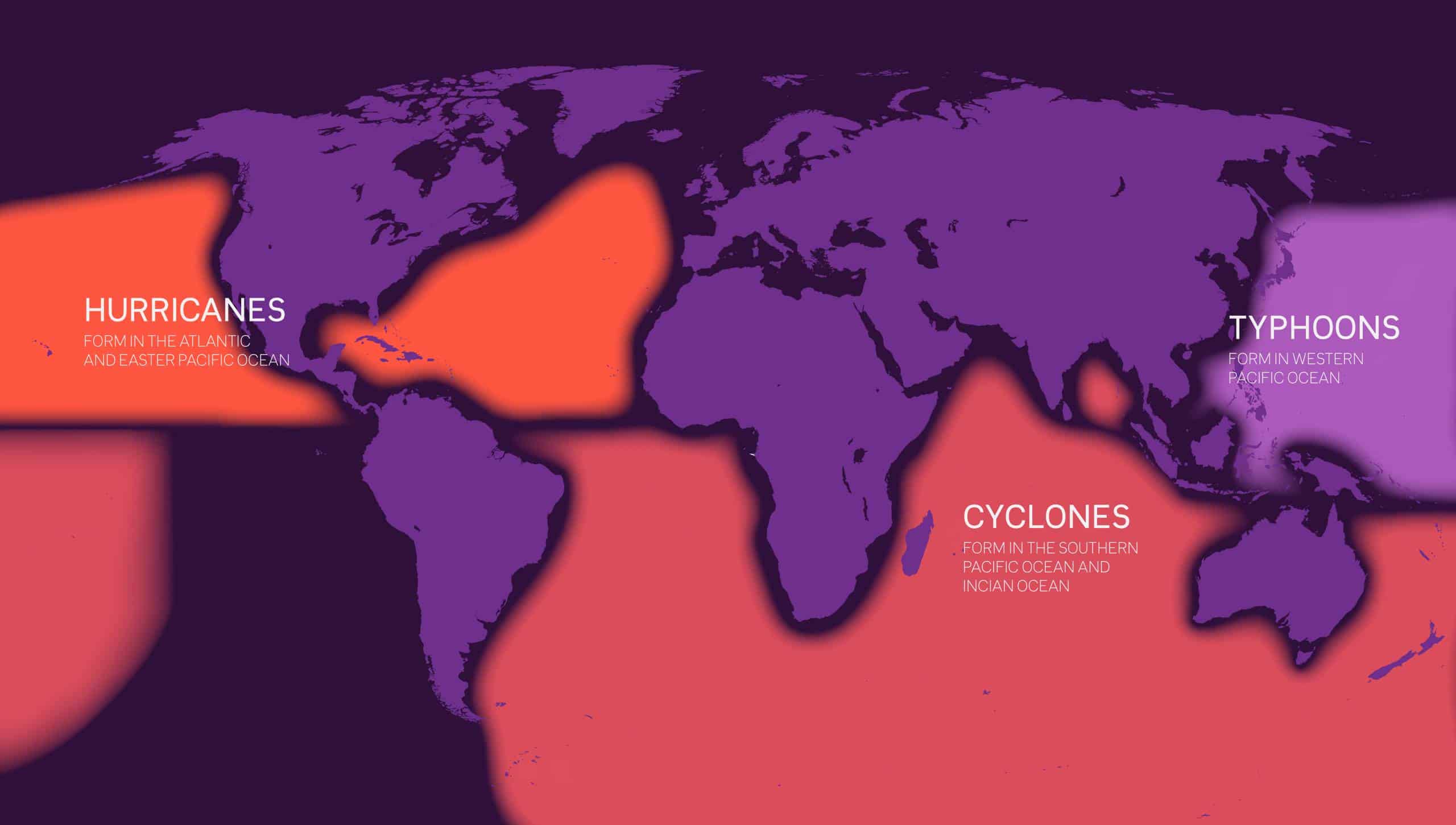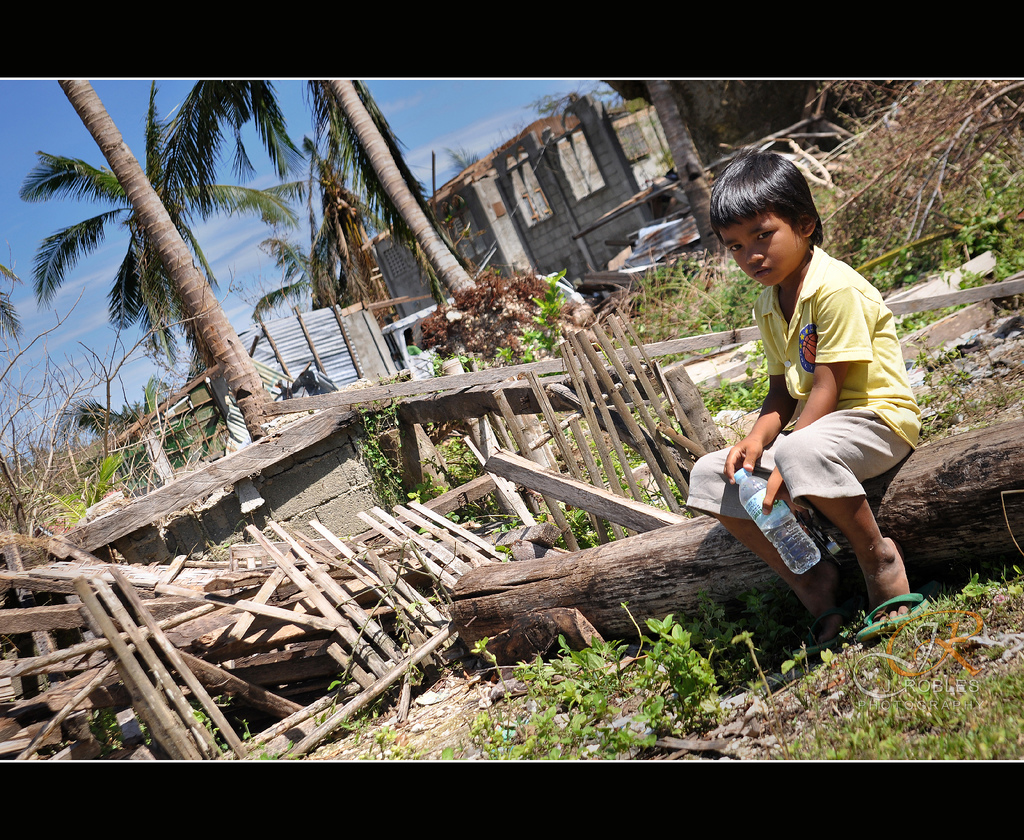Let’s start by calling a spade a spade… and a hurricane a tropical cyclone. That’s right: in the world of devastating marine storms, we use many names to call the same, and tropical cyclone is the only one that we can use in every case. More or less, anyway. To be brief, a tropical cyclone is a massive ocean storm that rotates around a center (which we call the eye), and which has very powerful winds associated. They always occur on tropical or subtropical waters. If it happens somewhere else, then it’s something else.
It all depends on location: a tropical cyclone that happens in the Northern Atlantic or Eastern Pacific (so around Central and North America on either side) is called a hurricane. If the tropical cyclone happens in the Western Pacific (the Asian coast down to Papua-New Guinea), it’s called a typhoon. And if it takes place anywhere in the Southern Hemisphere, we call it a cyclone. But they’re all the same thing.

Map: Lully Duque
Tropical cyclones are some of the most violent and dangerous extreme weather events in the whole world. Their impacts on coastal and island communities cost thousands of lives and billions of dollars every year.
As it usually happens with extreme weather events, the communities bearing the brunt are those in more vulnerable social situations. Lower income communities usually inhabit more precarious buildings and have less stable energy and water supplies. In addition to that, these communities often don’t have access to technology that would allow them to prepare or evacuate adequately. And when bad comes to worse, they are the ones with less mobility.
Actually, as the IPCC said in their sixth Assessment Report, tropical cyclones are among the main drivers of involuntary climate-related migration and displacement. Lower income communities are less responsible for climate change, but they are more affected. Injustice shines here.
Growing danger
Tropical cyclones have been around for thousands of years. They were here before humans and they will be here after we’re gone. They’re just a natural occurrence in our planet. However, they are getting nastier, and we’re here to show you how the fossil fuel industry is behind this dangerous, reckless trend.
Long story short: Tropical cyclones (remember, those can be called hurricanes, typhoons or, simply, cyclones) get fuelled by warm waters, so the warmer the surface of the ocean, the worse. And the warmer the air, the worse, too, because warmer air can absorb more moisture, and that means more rain. According to the IPCC’s latest report (AR6), the number of cyclones is not expected to grow, but their intensity is. That means more intense winds, more rainfall and more severe storm surges.

Aftermath of Typhoon Haiyan (Yolanda). Photo credit: Joemeth Robles/Flickr
The fossil connection
So we have the crime: a worsened humanitarian crisis. We have the weapon: more intense hurricanes, fuelled by global heating. Who’s the culprit? Let’s follow the footsteps back and see who’s there.
Global heating (the rise in the average temperature of the planet since the Industrial Revolution) is currently around 1,2º C. This increase in temperature is the direct cause of hotter oceans, higher sea level, hotter air. It’s the direct cause of more dangerous tropical cyclones. It’s the direct cause of avoidable suffering. And the work we’ll need to do to overcome those odds is more the more temperature increases.
And what causes global heating? Well, science is clear as water here. It is caused by an increase in the concentration of greenhouse gases, mostly (but not only) CO2 and CH4. These are found naturally in the atmosphere, but since we started massively burning fossil fuels, the concentration has been growing exponentially.
The increase in concentration of CO2 is linked to fossil fuels. There isn’t any other possible source (not volcanos, not clouds, nothing). Studies and data have widely proven that. CH4 is also massively linked to fossil fuels and land use change.
The coal, oil and gas industries have massively profited from it and they continue to profit from an economic model that forces people to use fossil fuels. Reports have proven that they knew the damage they were causing since at least the 1970s, and that, instead of abandoning their business model, they actively worked to disinform the public. They still do. We keep burning fossil fuels because they chose to use their power for that purpose.
But even if we cannot stop the hurricanes, we can stop the fossil fuels industry. People around the world have been fighting to keep coal, oil and gas in the ground, to cut the financial flows that allow this industry to still exist and to push for a more equitable and clean future. If you haven’t yet, join us!